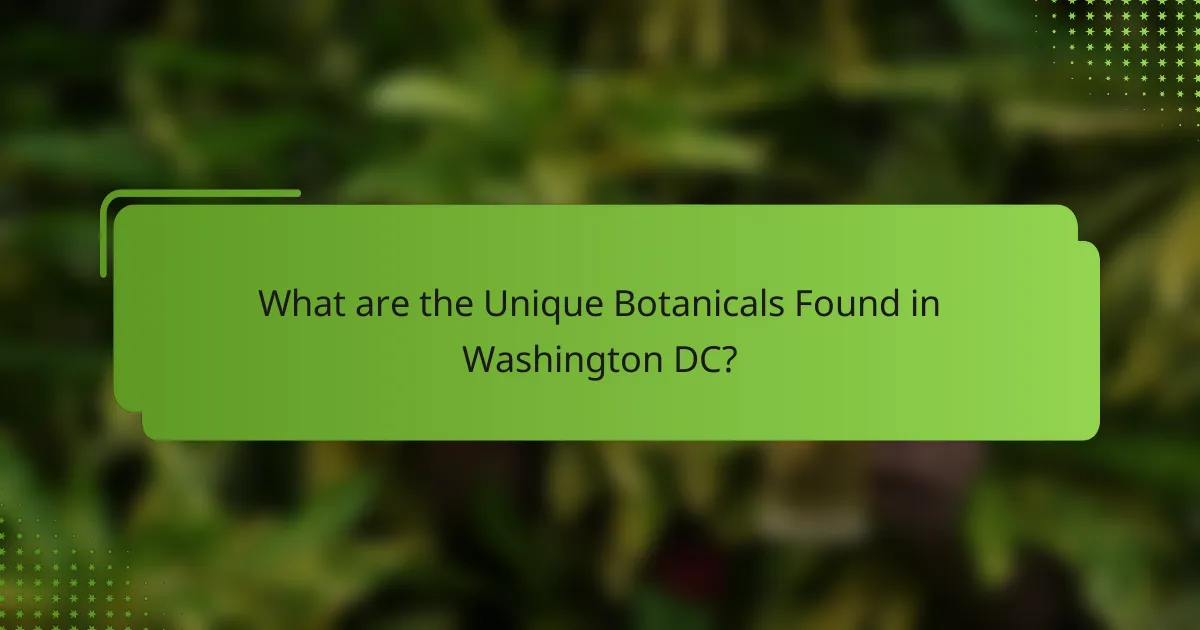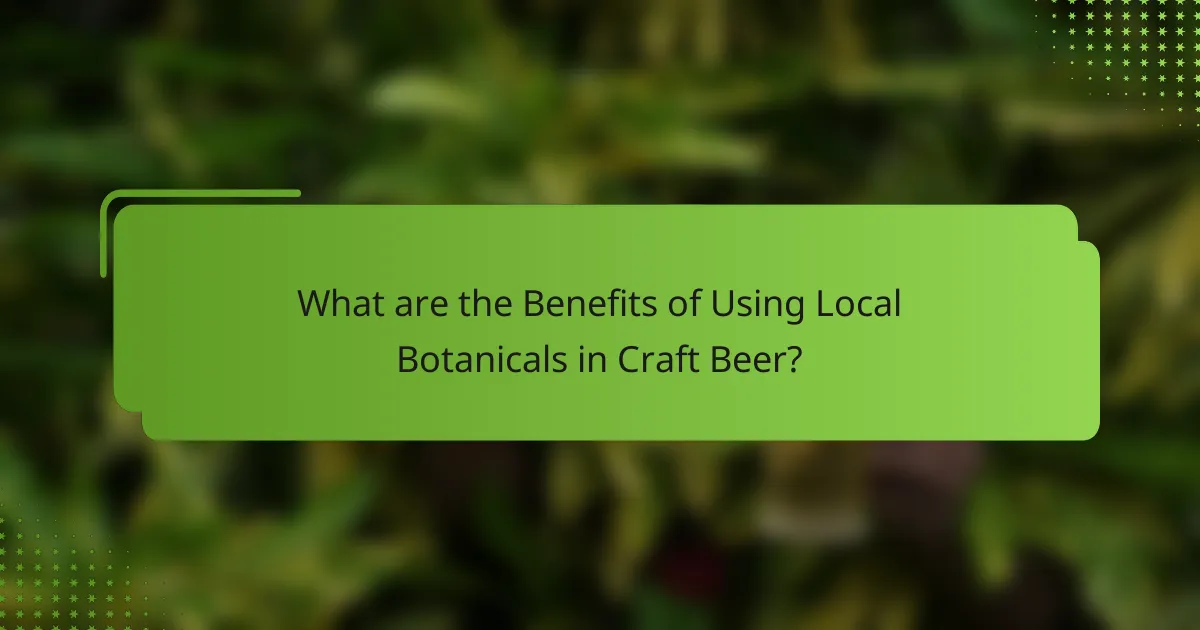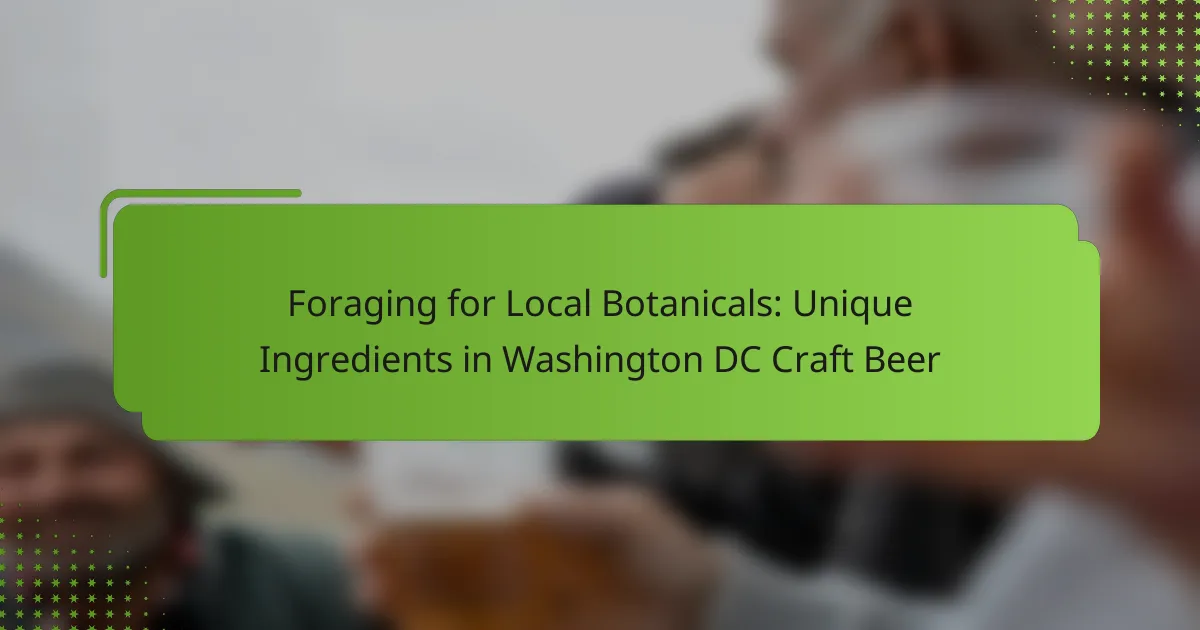Foraging for local botanicals plays a significant role in enhancing the craft beer scene in Washington DC. Key botanicals such as American ginseng, wild ginger, and black cohosh not only contribute unique flavors but also reflect the region’s agricultural heritage and sustainable practices. The use of these native ingredients supports local farmers, fosters community ties, and promotes environmental sustainability. Homebrewers can also incorporate these botanicals into their brewing processes, allowing for experimentation and connection to the local ecosystem. Overall, the integration of these unique ingredients enriches the craft beer experience while underscoring the importance of local sourcing.

What are the Unique Botanicals Found in Washington DC?
Washington DC features unique botanicals such as American ginseng, wild ginger, and black cohosh. American ginseng is known for its medicinal properties and is native to the region. Wild ginger, with its aromatic rhizome, adds a distinct flavor to local brews. Black cohosh is often used for its health benefits and has a historical significance in herbal medicine. These botanicals contribute to the unique flavor profiles in craft beers brewed in Washington DC. Their availability in local habitats makes them integral to the region’s foraging culture.
How do these botanicals contribute to local craft beer?
Botanicals contribute to local craft beer by enhancing flavor profiles and complexity. They introduce unique aromas and tastes that differentiate each brew. Common botanicals used include herbs, spices, and flowers. These ingredients can add bitterness, sweetness, or floral notes. Local breweries often source botanicals to reflect regional characteristics. This practice supports local agriculture and sustainability. For example, using locally foraged ingredients fosters a connection to the community. Research shows that incorporating botanicals can increase consumer interest and marketability.
What specific flavors do these botanicals impart?
Botanicals impart a range of specific flavors in craft beer. For example, juniper berries provide a piney and resinous flavor. Lavender contributes floral and herbal notes to the brew. Chamomile adds a gentle, apple-like sweetness. Mint introduces a refreshing, cooling effect. Dandelion greens can impart a slightly bitter, earthy taste. Each botanical enhances the complexity of the beer’s flavor profile. These flavors can significantly influence the overall drinking experience.
How do the growing conditions in DC affect these botanicals?
The growing conditions in DC significantly influence the characteristics of local botanicals. The climate in DC is humid subtropical, which provides ample rainfall and warm temperatures. These conditions promote the growth of diverse plant species. Soil quality in the area varies, impacting nutrient availability for botanicals. Urban pollution can also affect the health and flavor profiles of these plants. Seasonal variations lead to changes in botanical availability and potency. For instance, summer heat can enhance the aromatic qualities of herbs. Additionally, the presence of local wildlife can influence plant growth and reproduction. Overall, DC’s unique environment shapes the flavor and quality of botanicals used in craft beer.
Why is foraging for local botanicals important for craft brewers?
Foraging for local botanicals is important for craft brewers because it enhances the uniqueness of their beer. Using locally sourced ingredients creates distinct flavors that reflect the regional environment. This practice supports sustainability by reducing transportation emissions and promoting biodiversity. It also fosters a connection between brewers and their community. Local botanicals often have historical significance and traditional uses that can enrich the brewing narrative. According to a study by the Brewers Association, craft brewers who utilize local ingredients report higher customer engagement. This approach aligns with the growing consumer demand for authentic and locally inspired products. In summary, foraging for local botanicals contributes to flavor diversity, sustainability, and community connection in craft brewing.
What sustainable practices are involved in foraging?
Sustainable practices in foraging include responsible harvesting, species identification, and habitat preservation. Responsible harvesting ensures that only a portion of a plant is taken. This allows the plant to continue thriving and reproducing. Species identification prevents the collection of endangered or harmful plants. Foragers should educate themselves about local flora to avoid negative impacts. Habitat preservation involves foragers respecting ecosystems and avoiding overharvesting. Studies show that sustainable foraging can enhance biodiversity and ecosystem health. For example, the National Park Service promotes foraging guidelines to protect native species. These practices contribute to the sustainability of local environments and ensure the availability of resources for future generations.
How does foraging influence the local economy?
Foraging positively influences the local economy by providing unique ingredients for craft beer production. Local breweries benefit from the availability of foraged botanicals. This practice encourages sustainable sourcing and reduces transportation costs. It also supports local foragers, creating income opportunities. Increased demand for foraged ingredients can lead to market growth. A study by the University of Washington found that foraging contributes significantly to local food systems. This, in turn, enhances community engagement and promotes local tourism. Overall, foraging fosters economic resilience in local areas.

What are the Benefits of Using Local Botanicals in Craft Beer?
Using local botanicals in craft beer enhances flavor, supports local agriculture, and promotes sustainability. These botanicals provide unique tastes that differentiate beers. They often reflect the regional terroir, creating a sense of place in each brew. Supporting local farmers strengthens community ties and boosts the local economy. Sustainable practices associated with local sourcing reduce carbon footprints. Research indicates that locally sourced ingredients can improve freshness and quality. A study by the Brewers Association highlights that craft breweries using local ingredients often gain a loyal customer base. This trend fosters innovation and creativity in brewing.
How do local botanicals enhance the brewing process?
Local botanicals enhance the brewing process by adding unique flavors and aromas. These ingredients can include herbs, spices, and flowers sourced from the surrounding environment. The use of local botanicals creates distinctive profiles that differentiate craft beers. For example, ingredients like elderflower or chamomile can impart floral notes. Additionally, local botanicals can contribute to the overall complexity of the beer. They often reflect the terroir, showcasing the region’s biodiversity. This practice also supports local agriculture and encourages sustainability. Breweries that utilize these botanicals often attract consumers interested in unique and locally-sourced products.
What are the health benefits associated with these botanicals?
The health benefits associated with botanicals include various therapeutic properties. Botanicals can provide antioxidants that help combat oxidative stress. They may also possess anti-inflammatory effects, reducing the risk of chronic diseases. Some botanicals support digestive health through their natural compounds. Specific botanicals can enhance immune function, contributing to overall wellness. Additionally, certain botanicals have been linked to improved mental clarity and mood enhancement. Research indicates that botanicals like elderflower and dandelion may support liver health. The diverse phytochemicals found in these plants contribute to their health-promoting effects.
How do these ingredients create unique beer profiles?
Ingredients such as local botanicals significantly influence beer profiles. Each botanical brings distinct flavors and aromas. For example, herbs can add earthy or herbal notes. Fruits introduce sweetness and acidity, enhancing complexity. Spices contribute warmth and depth, creating unique taste experiences. The combination of these ingredients can result in innovative styles. Craft brewers often experiment with seasonal botanicals, reflecting local terroir. This practice fosters a connection between the beer and its environment. Ultimately, these unique ingredients differentiate craft beers in flavor and character.
What challenges do brewers face when foraging?
Brewers face several challenges when foraging for local botanicals. Identifying safe and edible plants is crucial. Many wild plants can be toxic or inedible, posing a risk to brewers. Seasonal availability of specific botanicals can limit options. Some plants may only be available during certain times of the year. Legal restrictions may also hinder foraging efforts in urban areas. Local regulations can prohibit foraging in public spaces or protected lands. Additionally, environmental factors such as weather can impact the growth of foraged plants. Unpredictable weather patterns can lead to poor yields. Lastly, knowledge and experience in foraging are essential. Lack of expertise can result in unsuccessful foraging trips.
How can brewers ensure they are foraging sustainably?
Brewers can ensure they are foraging sustainably by adhering to responsible harvesting practices. They should only collect plants in abundance and avoid overharvesting. This practice helps maintain local ecosystems. Additionally, brewers should educate themselves about local flora and their growth cycles. Understanding when and how to harvest sustainably is crucial. They can also collaborate with local conservation groups for guidelines. Engaging with these organizations promotes biodiversity and ecological health. Sustainable foraging practices support long-term availability of local botanicals for brewing.
What regulations must be considered when foraging in DC?
Foraging in Washington, DC is regulated by several laws. The National Park Service prohibits foraging in national parks. This includes areas like Rock Creek Park. Additionally, foraging on private property requires permission from the landowner. The DC Department of Energy and Environment regulates foraging in public spaces. Foraging must not harm the environment or disturb wildlife. It is also essential to identify plants correctly to avoid toxic species. Local regulations may vary, so checking with local authorities is advised.

How Can Homebrewers Incorporate Foraged Botanicals?
Homebrewers can incorporate foraged botanicals by selecting edible plants from their local environment. They should identify the botanicals that are safe and suitable for brewing. Common examples include herbs, flowers, and fruits. Homebrewers can use these ingredients in various stages of the brewing process. For instance, they can add them during the boil for flavor or in the fermentation stage for aroma. It’s important to properly clean and prepare the botanicals before use. Homebrewers should also experiment with different quantities to achieve desired flavors. Documenting the process helps in refining future brews. This practice not only enhances the beer but also connects brewers to their local ecosystem.
What are some tips for safely foraging local botanicals?
To safely forage local botanicals, first, identify plants with reliable identification guides. Use resources like field guides or mobile apps to confirm plant species. Avoid areas treated with pesticides or herbicides. Forage in clean, pollution-free environments. Always harvest a small amount to ensure sustainability. Educate yourself on toxic plants in your region to prevent misidentification. Remember to respect local laws and regulations regarding foraging. Lastly, consult local foraging groups or experts for guidance and shared knowledge.
How can homebrewers experiment with foraged ingredients?
Homebrewers can experiment with foraged ingredients by incorporating local plants and herbs into their brewing process. They should first research edible and safe foraged items in their area. Common foraged ingredients include wildflowers, fruits, and herbs. Homebrewers can add these ingredients during various stages of brewing, such as boiling or fermentation. This method can enhance flavor profiles and create unique brews. For example, adding wildflowers can impart floral notes. Additionally, using foraged fruits can add natural sweetness and complexity. Homebrewers should document their experiments to refine recipes over time. This practice not only fosters creativity but also connects brewers to their local environment.
What common mistakes should be avoided when foraging?
Common mistakes to avoid when foraging include misidentifying plants. Incorrect identification can lead to consuming toxic species. Always consult reliable field guides or apps for accurate identification. Another mistake is foraging in polluted areas. Contaminated plants can pose health risks. It’s also crucial to avoid overharvesting. Taking too much can damage local ecosystems. Ignoring local regulations is another mistake. Many areas have specific rules about foraging. Lastly, neglecting to consider seasonal changes can lead to missed opportunities. Some plants may not be available year-round.
Where can homebrewers find resources on foraging and brewing?
Homebrewers can find resources on foraging and brewing through various platforms. Online forums such as Homebrew Talk provide community advice and shared experiences. Websites like the American Homebrewers Association offer articles and guides on brewing techniques. Local workshops and classes often cover foraging and brewing topics. Books on foraging, such as “The Forager’s Harvest” by Samuel Thayer, provide in-depth knowledge. Additionally, social media groups focused on homebrewing can be valuable for connecting with experienced foragers and brewers. These resources collectively support homebrewers in enhancing their craft with local botanicals.
What local organizations support foraging and craft brewing in DC?
Organizations that support foraging and craft brewing in DC include the DC Craft Brewers Guild and the Washington Area Bicyclist Association. The DC Craft Brewers Guild promotes local breweries and their unique ingredients. They often collaborate with foraging groups to source local botanicals. The Washington Area Bicyclist Association encourages sustainable practices. They support events that highlight foraging and its role in brewing. Other local groups like the DC Foragers also advocate for foraging education and community events. These organizations collectively enhance the craft brewing landscape in Washington DC.
How can homebrewers connect with local foragers and brewers?
Homebrewers can connect with local foragers and brewers through community events and social media groups. Participating in local craft beer festivals fosters networking opportunities. Joining foraging workshops can enhance knowledge and build relationships with foragers. Engaging in online platforms like Facebook groups dedicated to homebrewing and foraging facilitates information exchange. Attending local farmers’ markets allows homebrewers to meet foragers directly. Collaborating on brewing projects with local breweries can also create connections. These methods encourage sharing knowledge and resources among enthusiasts.
Foraging for local botanicals is a vital practice in Washington DC’s craft beer scene, highlighting unique ingredients such as American ginseng, wild ginger, and black cohosh. These botanicals enhance flavor profiles, support local agriculture, and promote sustainability within the brewing community. The article explores how these ingredients contribute to the complexity of craft beers, the impact of local growing conditions, and the importance of sustainable foraging practices. Additionally, it addresses the challenges brewers face when foraging and provides insights for homebrewers on incorporating foraged botanicals into their brewing processes. Overall, the piece underscores the connection between local ecosystems and the craft brewing industry in DC.
